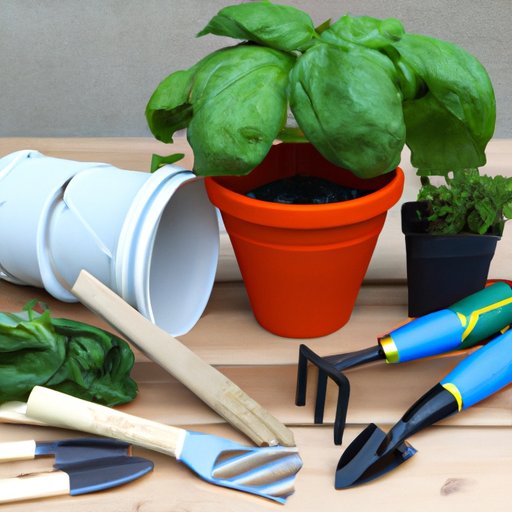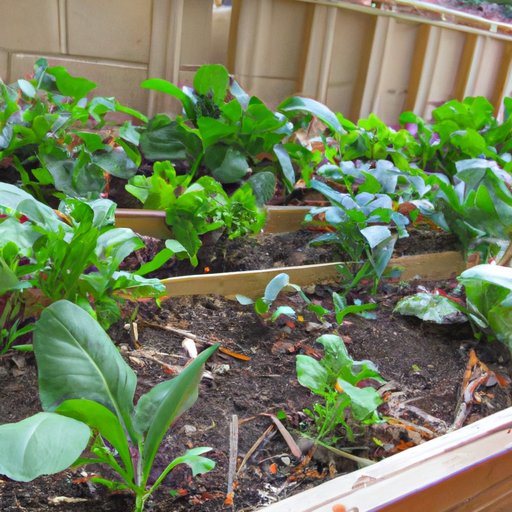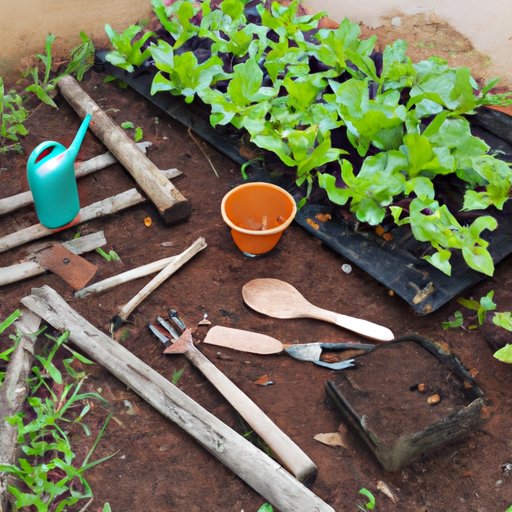Introduction
Growing your own vegetables is a great way to save money, enjoy fresh produce, and even get some exercise outdoors. But if you’re short on space or don’t have access to a large backyard, you can still enjoy the benefits of having a vegetable garden with a small vegetable garden.
A small vegetable garden is any type of garden that is no larger than 250 square feet. It’s typically planted in containers, raised beds or a small patch of land. The size of the garden limits the types of plants you can grow, but it doesn’t mean you have to sacrifice variety. With careful planning and proper care, you can have a thriving small vegetable garden that yields plenty of delicious produce.
Step-by-Step Guide to Planting a Small Vegetable Garden
Once you’ve decided where to put your small vegetable garden, it’s time to get started planting. Here’s a step-by-step guide to help you get started.
Preparing the Soil
Before you plant anything in your small vegetable garden, it’s important to prepare the soil. The type of soil you use will depend on the type of plants you’re growing. If you’re using containers, be sure to buy potting soil specifically made for containers. If you’re planting in the ground, you may need to add compost or fertilizer to the soil to improve its quality.
Planting Seeds or Seedlings
Once you’ve prepared the soil, you can start planting. You can either plant seeds or seedlings, depending on what type of vegetables you’re growing. If you’re planting seeds, be sure to follow the instructions on the package. If you’re planting seedlings, make sure to dig a hole that’s big enough to fit the root ball and fill it with water before planting.
Watering and Mulching
Once your plants are in the ground, you’ll need to water them regularly. Depending on the type of plants you’re growing, they may need more or less water. Make sure to check the soil before watering to ensure it’s not already saturated. In addition to watering, you should also mulch around the plants to help retain moisture and keep weeds at bay.
Tips for Choosing the Right Spot for Your Small Vegetable Garden
When choosing a spot for your small vegetable garden, there are several things to consider. Here are a few tips to help you find the perfect spot.
Sunlight
Most vegetables need at least six hours of direct sunlight a day, so make sure to choose a spot that gets plenty of sun. If you’re limited on space, you may want to consider planting vegetables that don’t require as much light such as lettuce and spinach.
Soil Quality
The quality of the soil is also an important factor when choosing a spot for your small vegetable garden. Make sure to test the soil to determine if it has the right pH level and nutrient content. If the soil is too acidic or lacks certain nutrients, you may need to add amendments such as compost or fertilizer.
Drainage
Proper drainage is also essential for a successful vegetable garden. Make sure to choose a spot that won’t become overly saturated after a heavy rain. If the area doesn’t have good drainage, you may need to install a drainage system or choose another spot.

What Supplies You Need to Start a Small Vegetable Garden
In order to have a successful small vegetable garden, you’ll need the right supplies. Here’s a list of items you’ll need to get started.
Containers
If you’re planting in containers, you’ll need to make sure you have the right size and type of container for the plants you’re growing. Consider the size of the plant and how much soil it needs to thrive.
Fertilizer
Fertilizer is important for providing essential nutrients to your plants. Choose a fertilizer that’s specifically designed for vegetables and follow the instructions on the package.
Compost
Adding compost to the soil helps improve its texture and nutrient content. Compost is easy to make at home or you can buy it from a garden center.
Tools
You’ll need a few basic tools to help you maintain your small vegetable garden. A shovel, rake, hoe, trowel, and pruning shears are all essential tools.

The Best Veggies to Plant in a Small Vegetable Garden
When choosing vegetables for your small vegetable garden, it’s important to pick varieties that are best suited for small spaces. Here are some of the best veggies to plant in a small vegetable garden.
Leafy Greens
Leafy greens such as lettuce, spinach, kale, and Swiss chard are all great options for a small vegetable garden. They don’t take up much space and can be harvested multiple times throughout the season.
Tomatoes
Tomatoes are one of the most popular vegetables to grow in a small vegetable garden. There are many varieties available, including determinate and indeterminate varieties. Determinate varieties are best for small spaces because they don’t get too tall.
Peppers
Peppers are another great option for a small vegetable garden. They come in a variety of shapes and sizes, so you can choose the ones that best fit your space.
Squash
Squash is another great option for a small vegetable garden. There are a variety of squash varieties, including summer squash, winter squash, and pumpkin. Summer squash grows quickly and can be harvested multiple times throughout the season.

How to Care for and Maintain a Small Vegetable Garden
Caring for and maintaining a small vegetable garden requires regular attention and effort. Here are some tips to help you keep your garden healthy and productive.
Watering
Watering is essential for a healthy vegetable garden. Make sure to check the soil before watering and only water when the soil is dry. Over-watering can cause the roots to rot and can kill your plants.
Mulching
Mulching is important for keeping weeds at bay and retaining moisture in the soil. Make sure to spread a layer of mulch around your plants to help keep them healthy.
Weeding
Weeds can compete with your plants for nutrients and water, so it’s important to keep them under control. Check your garden regularly for weeds and remove them as soon as you see them.
Pest Control
Pests can cause damage to your plants and should be controlled as soon as possible. Monitor your garden for signs of pests and take action if needed.
Harvesting
Finally, don’t forget to harvest your vegetables when they’re ready. Harvesting at the right time ensures that your vegetables are ripe and full of flavor.
Conclusion
Having a small vegetable garden is a great way to enjoy fresh produce, save money, and get some exercise outdoors. By following these steps and tips, you can have a thriving garden that yields plenty of delicious produce. Be sure to prepare the soil, choose the right spot, select the right supplies, pick the best veggies to plant, and take proper care of your garden for the best results.
(Note: Is this article not meeting your expectations? Do you have knowledge or insights to share? Unlock new opportunities and expand your reach by joining our authors team. Click Registration to join us and share your expertise with our readers.)
